By Scott Smith
One of the most beneficial changes that you can make to a handgun is the sights. Most pistol sights while serviceable leave a lot to be desired. The front sight is boxy covering a major portion of the target while the notch of the rear barely allows for “proper” alignment with the front sight. Factory sights also tend to be too busy with white outlines, three dots; distracting from aligning the front sight on target.
While those who shoot bullseye prefer narrow black front sights and tight square notched black rear sights for accuracy, they do not work well for competition and self-defense/duty applications. For dynamic events you need sights that draw your eye to the front sight/target quickly while giving good accuracy from contact distance and beyond.
Over the last several years we have seen many improvements in sights for handguns. One of the first major changes was the advent and rapid development of tritium sights. These allowed shooters to “see” their sights in low light situations and to accurately engage a target. During the late nineties and into the early years of the twenty first century these were the go to sights, still are for duty applications. For other applications they were only a little better than factory sights because of requirements placed on their manufacture by the NRC, tritium is radioactive you know.
The next major change was using fiber optic tube in sights. These glowed brightly in normal light, came in various colors and could be installed on narrow sights since they are not radioactive. In their early days they were fragile and needed replacing frequently, which is not the case today. Today, fiber optic front sights dominate the world of competition shooting and upland hunting.
What we are seeing today is the next big change in sights for handguns with the move toward mounting mini-red dot sights on slides or on an auxiliary mount. This is nothing new because USPSA Open Class pistols are where we first saw red dot sights being mounting for competition. Open Class forced dot manufacturers to make durable optics which eventually led to the military using red dots on M4/M16s for duty use. Now action shooting is driving the next revolution mounting durable mini red dots on carry pistols with the new Carry Optics Class.
However I am getting ahead of myself, let’s get back to fiber optic and enhanced tritium sights. The last five years has seen participants in action shooting force manufacturers build sights that meet their needs and those of hardcore SWAT/special operations operators. Because of this today’s fiber optic sights are far more durable, more useful and function on all forms of firearms.
So let’s take a look at sights and see what is out there. One of the best known names in sights and optics is Trijicon. In many ways Trijicon is the first make in tritium sights. Back in the early nineties I recall Trijicon being the go to company to have tritium inserts installed on Novak Sights or Heinie Sights. They then became the “only” sight to have on a duty pistol for good reason; their brightness and indestructibility. I confess I was addicted to them the first time I used them during low light training and during low light stages shooting IDPA.
Trijicon never sat on their successes and continue to be on the cutting edge today. Their latest sight the HD series combines a green tritium vial surrounded with photoluminescent paint on the front sight. This paint is either HiViz Yellow or HiViz Orange. These colors work well even for those who are color blind. The rear sight is a “U” notch that is accurate and allows the eye to naturally center the front sight. You will find a green tritium vial on either side of the notch. Trijicon has mastered making the front vial look larger in low light, which is important when you shoot three dots at night.
These sights are a serious use sight that is versatile enough to be used for competition, duty or personal protection. These sights vary in price depending on what pistol you have. They average about $170, in my experience they are worth it. Mine have been banged, dropped and used in all weather conditions and still are shining bright.
If you are looking for the most options in sights, it is hard to beat Ameriglo. Over the last few years Ameriglo has custom designed sights for the likes of Ken Hackathorn, Dave Spaulding, Kyle Defoor as well as their traditional tritium, fiber optic or OEM style sights. The prices of these sights range from $35 to $140 depending on which model you choose. The reason for such a wide range in prices is how many tritium vials the sights have, are they black on black, is there fiber optics and what combination you choose. Ameriglo also sells just the front or rear sight when that is all you need.
I have been using Protector Sights on a Glock 19, Hackathorn’s for Sig P229 and I-Dots on an S&W M&P 9. Both of styles of sights have florescent rings around the front tritium vial. This vial draws your eye to the front sight in daylight conditions which aids in faster sight acquisition. Another feature of Ameriglo sights that aids in picking up the front sight is having wider notches in the rear sight. For those of us with well over eighteen eyes this extra daylight allows our eyes to track and more quick align the sights. Another feature of the rear sights is the squared but not sharp front edge of the sight. This allows you to do one handed racking of the pistol using the sight as a hook. With few exceptions the rear sights extend from the sight notch to the back of the slide to give you the longest sight radius possible.
About half of Ameriglo’s rear sights are serrated plain black like the rear that in the Protector or smooth on the Hackathorns. This takes away the distractions of dots on the rear sight. When you have traditional three dot sights, your eyes struggle to focus on front vs. rear sight; it’s something you are not aware of. This can cause eye strain and poor shot placement. The exception to that seems to be single dot of the I-Dot or bar rear sights like the CAP rear; which your eyes naturally align the front over the rear. My optometrist is a CMP/PPC shooter and he schooled me up on this and the ophthalmologists on his staff added other technical details that I just shook my head and agreed with. Since going to plain rear sights I have found I shoot better.
Over the last year I have the I-Dot, Hackathorns and Protector Sights to be ideal for my needs. The G19 and P229 are my daily carry pistols of choice because of their size with the M&P coming a close second. All three pistols with their respective Ameriglo sights have proven themselves capable shooting police qualifications or on the competition field. Ameriglo’s sight designs are tough, functional and easy to acquire. If you need another reason to use Ameriglo sights; Trijicon installs the tritium vials to Ameriglo specifications. You get innovative durable sights all in an affordable package.
When one hears the name Sig Sauer, sights might not be the first thing that comes to mind. If you own a Sig pistol, this will change now with the introduction of Sig’s X-RAY3. These sights are a major improvement over Siglites, the first tritium sights offered by Sig Sauer.
First off the X-RAY3 offers you a traditional square notch or a “U” notch rear. The X-RAY3s installed on my older P225 are the “U” notch variety. Over the past few years I have found this style rear sight fits my applications and eyes better than a square. For low light shooting there are two tritium vials in the rear sight, so you have three dots.
The wide rear notch allows the bright green florescent polymer ring of the front sight to quickly align evenly. The green ring was just the right shade, even in the lush greenness of spring in the Northeast. I was skeptical about how bright this ring would be in shade or similar conditions, but that fear was not warranted. This ring shined in most ambient light and when it was not visible, the tritium picked up the slack.
Once the X-RAY3s were installed it was off to the range. Since my P225 is far from being a current production piece, I was pleased to see that point of aim/point of impact was dead on from contact to twenty five yards. The X-RAY3s will set you back $130 for a set, but if you carry a Sig Sauer; these sights need to be on it. Sig expects the vials to last at least ten years and is warranting them for five. They have been tested up to twenty thousand rounds and have not failed. Like Sig Sauer pistols, the X-RAY3s will be to hell and back tough.
The last set of sights I tested this year is from The Mako Group, Meprolight’s American distributor. The R4E Optimized Duty Sight-ODS was built for full sized Glocks to give you a precision sight picture. The ODS has a tritium vial front sight, with two horizontal and one vertical vial in the rear to form a “cross hair” in low light. In daylight there is a white has under the front vial to give more precise alignment with the rear.
I gave these sights to a bud of mine to test on his issue training pistol to ring out during evolutions with his agency. These sights proved themselves to be quite accurate at longer distances versus traditional three dot sights. The four visible alignment marks took guess work out of finding the sight picture. With traditional three dot tritium, it possible to misalign the front sight to one side or the other of the rear sight; making for a wicked miss. On a square range it’s no big deal, but can lead to vast amounts of litigation for a self-defense or duty application.
Last I talked with him he was still running the Meprolight ODSs on his training Glock. These sights help lesser skilled shooters learn proper sight alignment. The ODS allows them to see the “perfect” sight picture versus envisioning it. This alone has been a good reason for an agency to use these sights.
He told me the sights worked well shooting IDPA. The vials become white lines and a dot in daylight. Aligning them was just like looking at a number of reticules in optics. The R4E ODS sights will set you back $158.85, all that tritium and proper machining costs. If you are an instructor, I suggest using these sights on training Glocks just like my bud does. Giving your students that instant visual of the proper sight picture alone pays for the sights.
If you mainly are a competitive shooter, you will be hard pressed to beat a fiber optic front sight mated with a square or “U” rear notch plain black sight. This has become the dominate set-up of most of the top shooters. The reason is simple; it is a wicked fast sight to find. The fiber optic glows in normal lighting just like a red dot sight does. You can find fiber optic and rear sights from most of the manufactures today; Heinie, HiViz, Truglo, Dawson Precision, 10-8 Performance, Warren Tactical Sights, Proctor Sights and most can be found at Brownells.
When searching for sights you will find sights that match up to your factory rear, complete sets, front sights of various heights to adjust your point of aim/point of impact, narrower front sights for more precision or speed depending on your specific application. Unlike fiber optic sights of days gone by today’s sights are very durable and it is easy to replace the fiber to change color or when one breaks. Front and rear sights each range in price from $30-50, depending on the manufacturer.
As you can from my well used pistols there are many options for sights on the market today. Quality replacement sights will make you a better faster shot, as long as you do your part; practice. This is one accessory that you will reap the rewards of the money spent. I have found most places you purchase sights will install them, or as in many cases; folks you shoot with can help. If neither of those works for you, check online. I guarantee you will find the information you need.
I hope this overview of sights will give you some options for your handguns and improve your shooting. As always get out to the range; shoot straight, shoot safe and have fun. This year if you wish to keep your Second Amendment Rights, make sure you support the NRA, Gun Owners of America, The Second Amendment Foundation and vote for a pro-gun candidate.
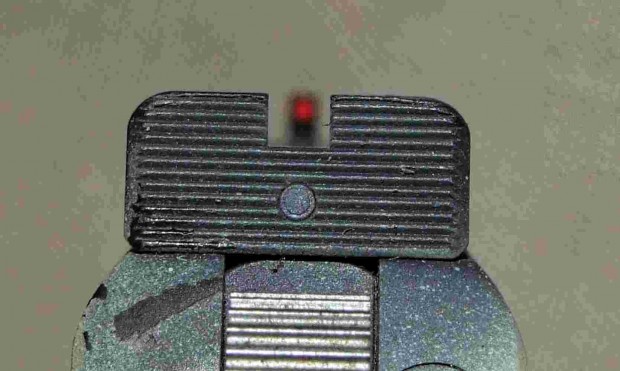
Heinie Rear Sight, this is a Straight 8 with centered tritium vial. This sights gives a sharp fast sight picture.

Warren Tactical Rear Sight, with the scallops you see more target area while the “U” notch allows your eye to center the front sight.
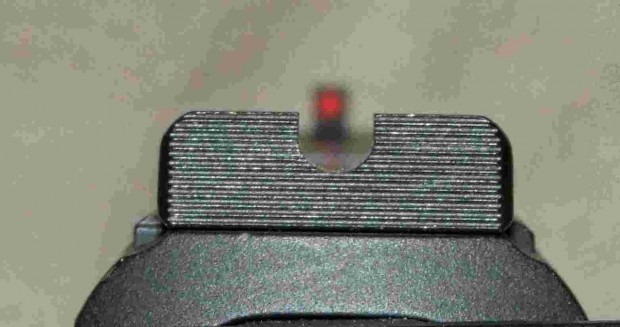
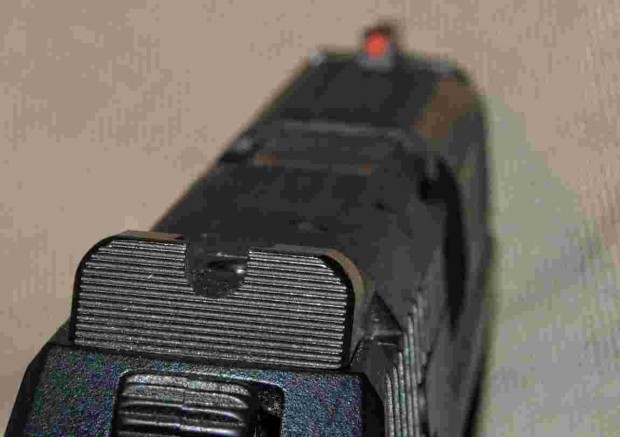
10-8 Performance’s rear sight with its “U” notch is fast while the sight is tough enough to survive using it to rack your pistol off something as hard as a 2X4.


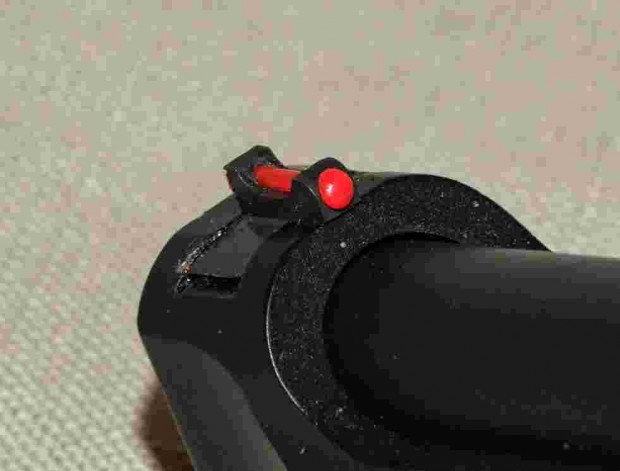
Wlison Combat Battlesight on Wilson Beretta 92G S-D the rear is low profile and fast while the fiber optic front is durable and bright.

Procotor’s “Y” rear sight is fast like a u notch and precise as a traditional square notch. Former Special Forces Operator Frank Proctor and designer used this sight to shoot his way to Grandmaster in USPSA Limited Class.

Dawson Precision Fiber Optic Front sight, this sight is designed to allow the pipette to lock inside the sight hood to eliminate the halo effect that can happen with fiber optics. This allows the sights to be precise and fast.
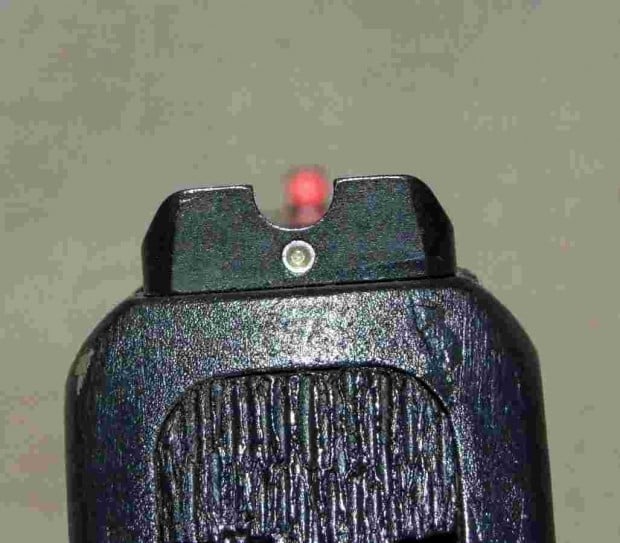
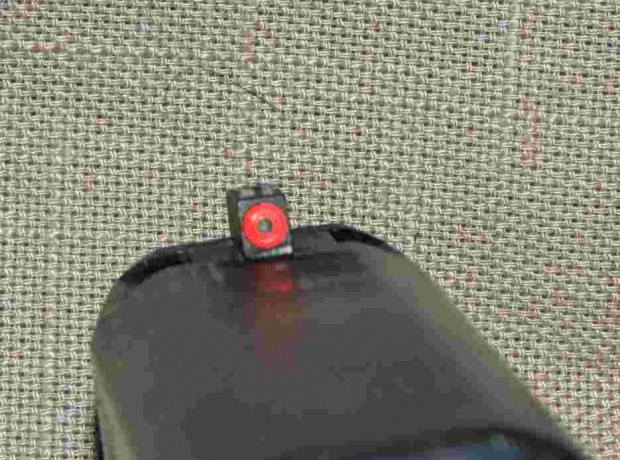
This Ameriglo’s I-Dot for S&W’s M&P. In low light simply align the front tritium dot over the rear, you are on target. In daylight the front sight settles right into the wide “U” notch.

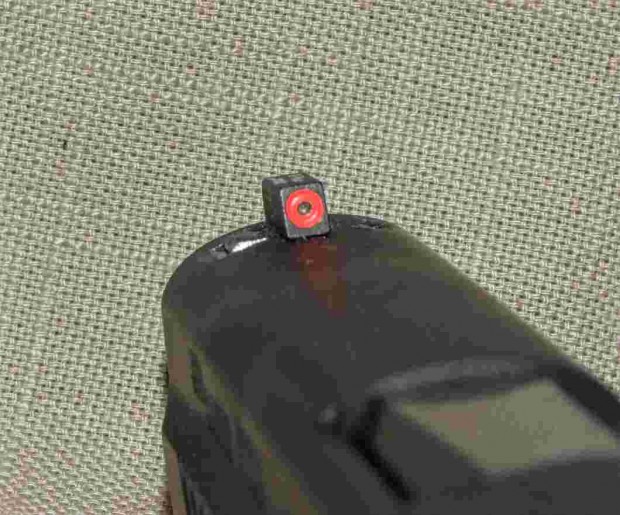
Hackathorn Sight by Ameriglo is a simple sight that combines a wide square notch rear with a bright luminescent/tritium front sight for use in all light conditions.

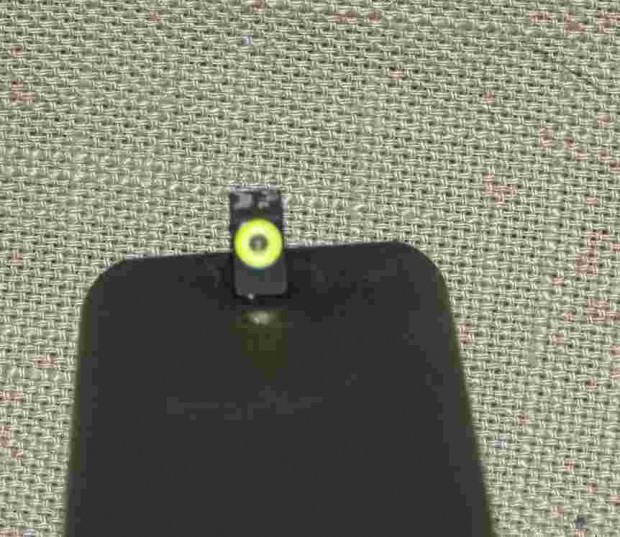
Protector Tritium Glock sights by Ameriglo are similar to Hackathorn’s but are serrated and the sight tunnel is slightly different. These sights too are fast, accurate and durable.

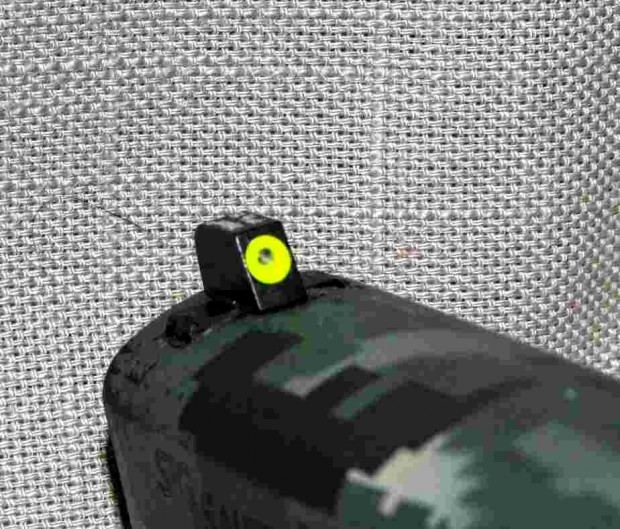
Trijicon’s HD Sights are the sights by which all tritium sights are compared to. They are the boldest sights in Trijicon’s line and will go from the competition range to duty.
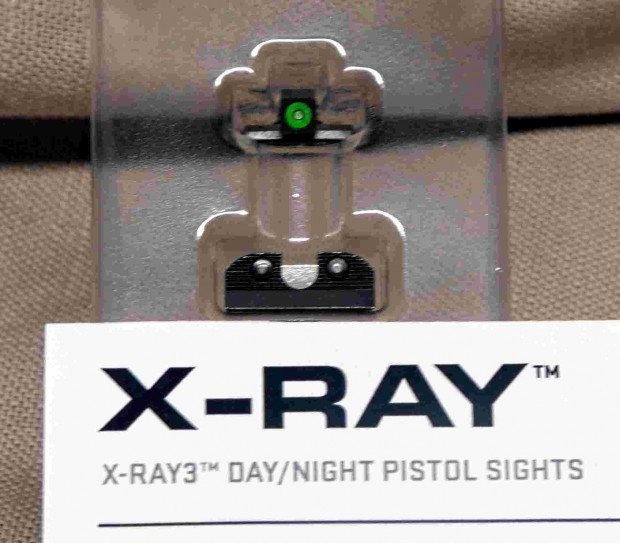
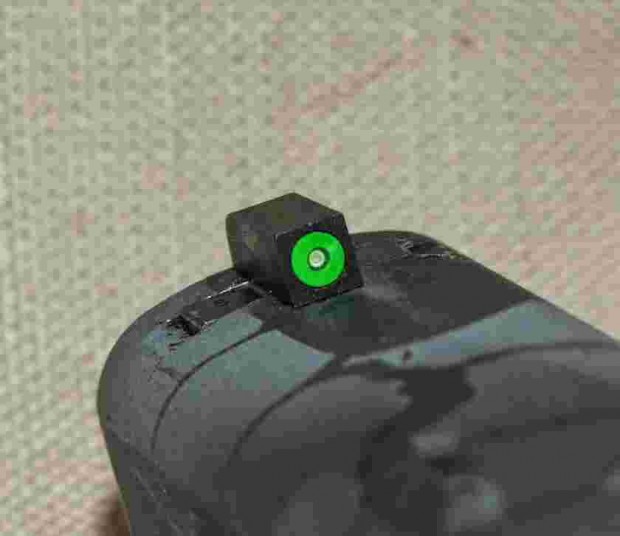
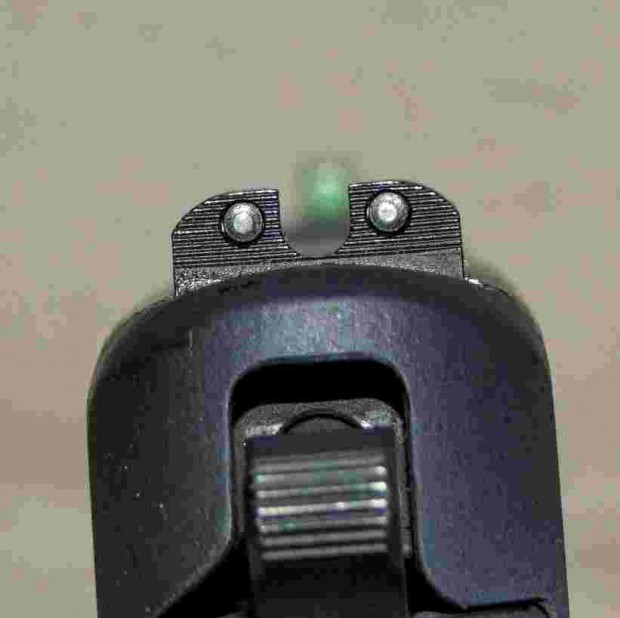
Sig Sauer’s X-Ray sights. With their fiber luminescent ring around the tritium vial they are the closest sights I have seen to a hard use fiber optic/tritium sight. If you have a Sig, these need to be on it.
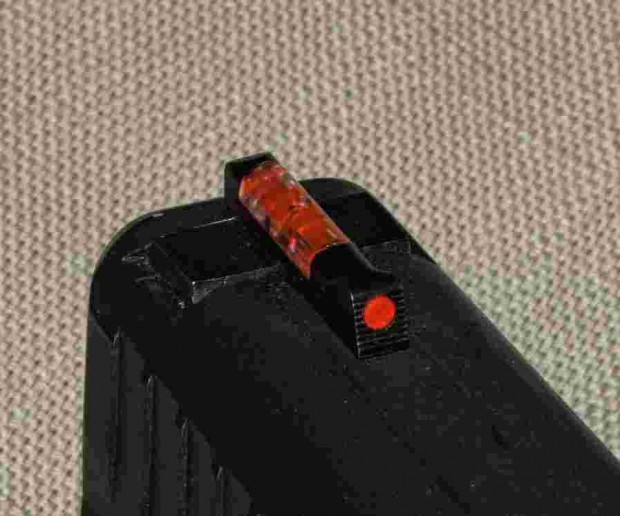
Hi-Viz’s Over Molded Front Sight, is the toughest fiber optic sight I have used. This one has been on this P30 since the P30 was introduced and shows no signs of breakage.
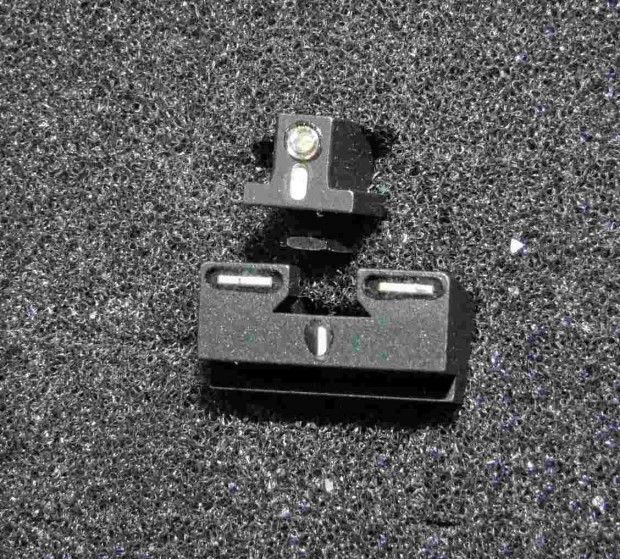
Meprolight’s Optimized Duty Sight, showing the “crosshairs” lf the front and rear sight for precise shot placement with your Glock.
—–
Scott Smith is a Disabled Veteran serving in the Army and USAF Reserve. He has been a federal police officer, is a charter member of IDPA and is actively involved with USPSA and various three gun competitions.


